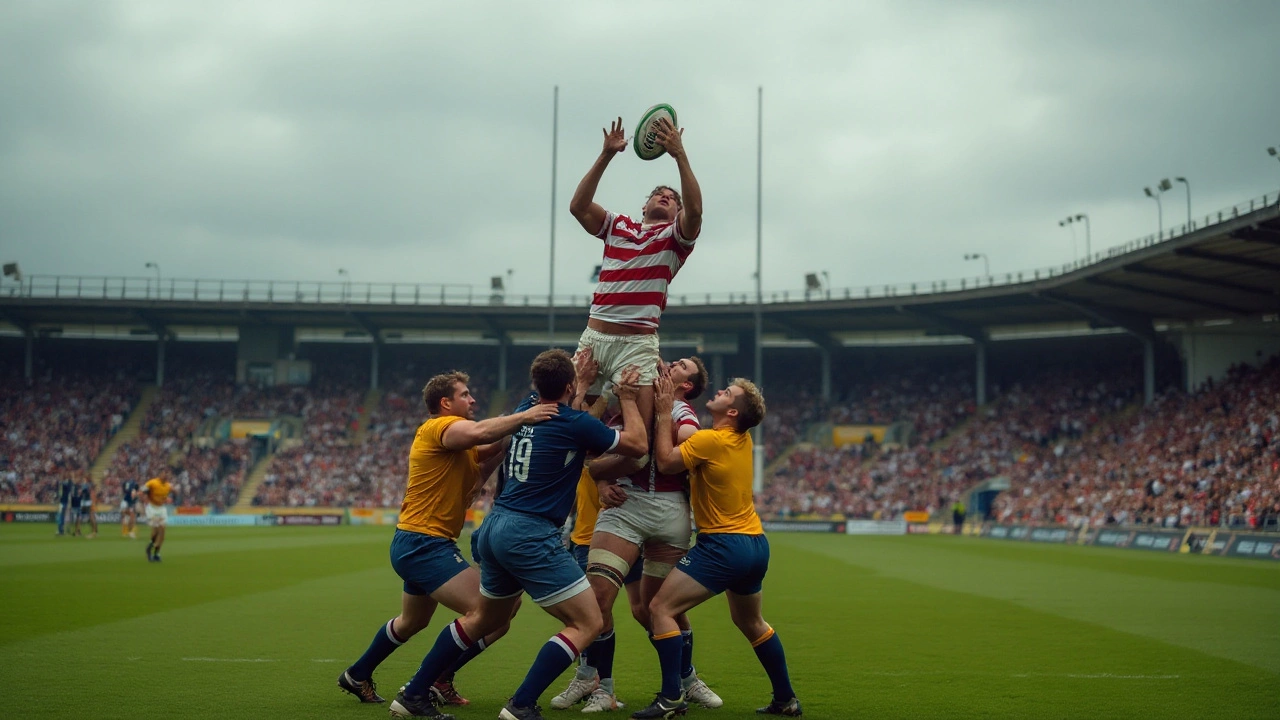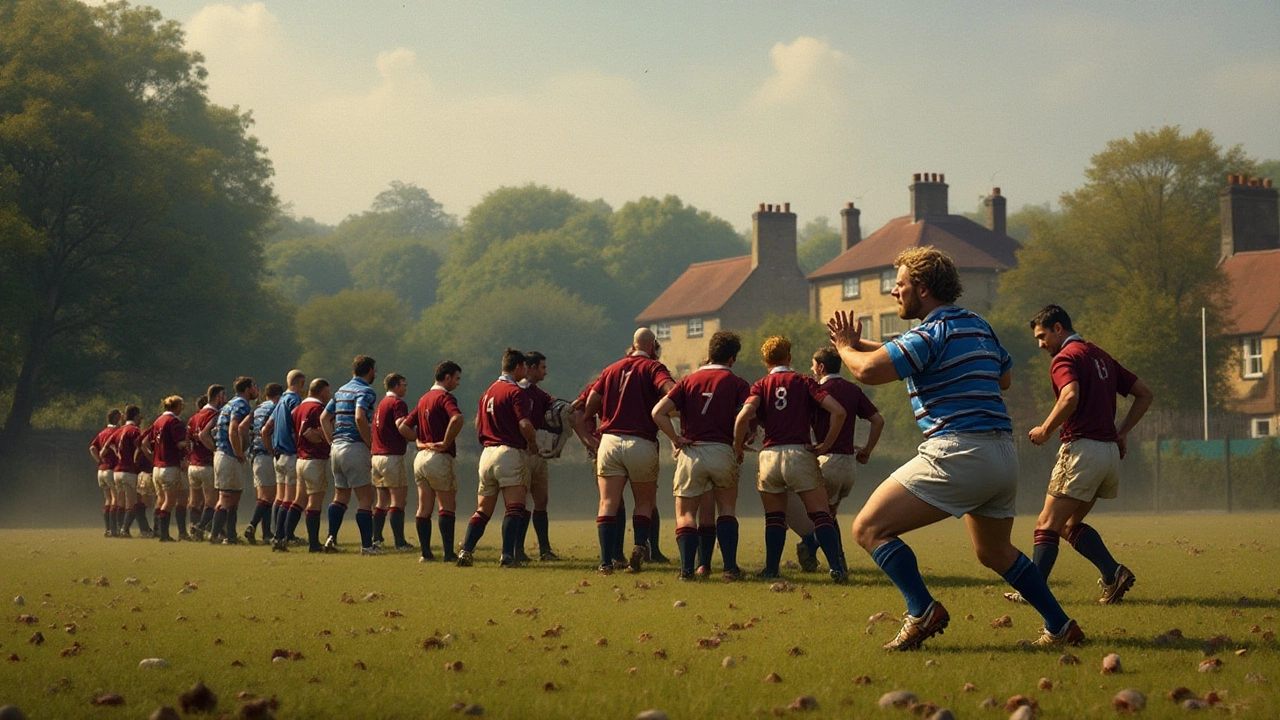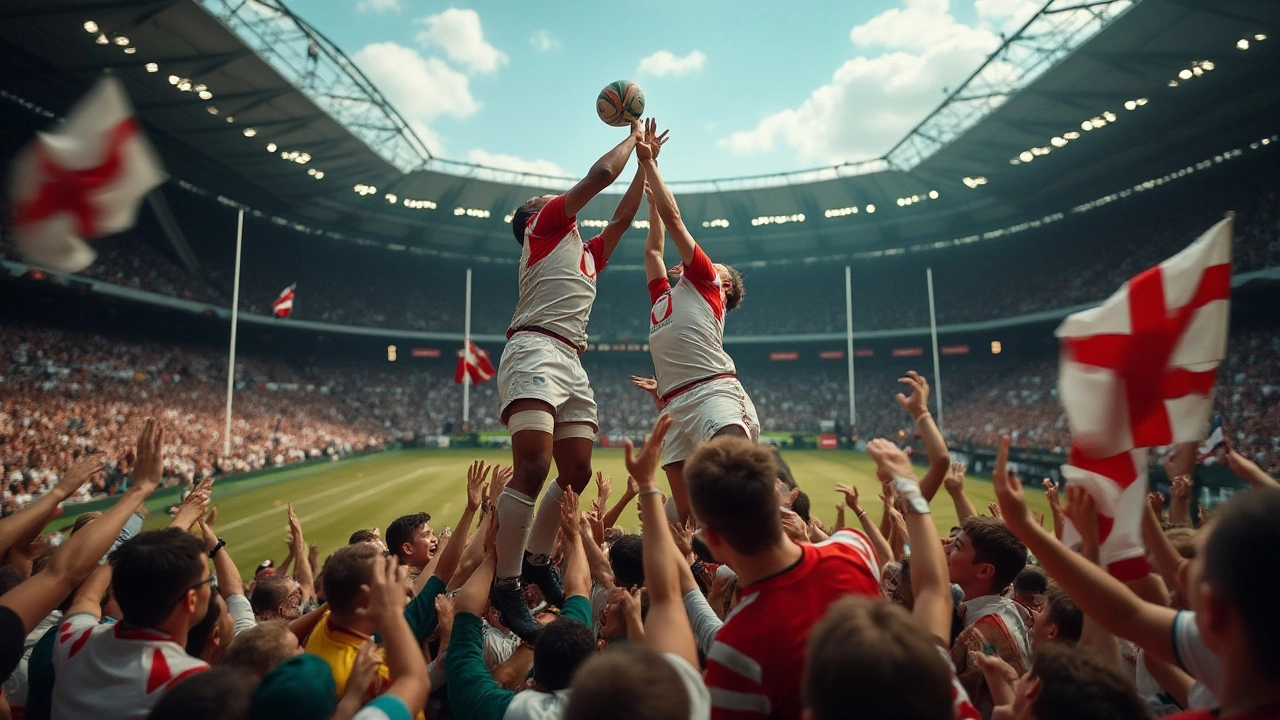Understanding Rugby Lifts: The Role of the Lineout
 Dec, 8 2024
Dec, 8 2024
Rugby, a sport known for its blend of physicality and finesse, features an intriguing aspect called the lineout. It's a moment in the game when players are lifted high into the air, resembling a choreographed dance of strength and precision. This technique is more than just a spectacle; it's a strategic move designed to reclaim possession and reset the flow of the game. Understanding the mechanics of a rugby lift provides insights not only into the sport's strategic nature but also into the teamwork and skills required to execute it successfully.
For those unfamiliar with rugby's intricacies, the lineout can seem like a complex maneuver. Yet, it's a cornerstone of the game, involving precise timing and roles for each player involved. From the lifters who anchor the play to the flyer who soars to capture the ball, each participant has a crucial part to play. Dive into this article as we unpack the elements that make a rugby lift such an essential part of the game.
- Introduction to Rugby Lineouts
- The Mechanics of Lifting
- Roles and Responsibilities
- Improving Your Lineout Skills
Introduction to Rugby Lineouts
In the compelling world of rugby union, few moments capture the imagination quite like the rugby lift in a lineout. This tactical play is not only a display of raw power and precise teamwork, but it also offers a momentary pause in the chaos of the game, allowing teams to reset and strategize afresh. A lineout occurs when the ball goes out of play along the sideline, prompting both teams to form lines perpendicular to the touchline. The objective is simple yet demanding: to secure possession through a well-executed throw, timed jumps, and well-coordinated lifts. It's a test of prowess where height and timing can tip the scales in favor of either side.
The origins of the lineout are steeped in the history of rugby, evolving alongside the game from its chaotic roots to the structured and strategic play we see today. It's fascinating to note that lineouts were not always a central part of rugby; rather, they developed as the game took a more organized form. The lineout is now a key phase in the game, often dictating the tempo and fluidity of play. Teams often dedicate significant training time to perfecting their lineout tactics, recognizing its potential to radically alter the direction of a match. This necessity for precision makes understanding the intricacies of a lineout essential for any serious rugby enthusiast or player.
In terms of execution, the lineout is a beautifully choreographed affair. The thrower, usually the hooker, must release the ball at just the right height and speed, allowing the jumpers to time their ascent perfectly. With one or more players lifted high by their teammates, often reaching over three meters off the ground, the lineout is a scene of intense concentration and balance. Some teams employ complex codes and signals to execute their set pieces, keeping opponents guessing and reducing the predictability of their plays. According to former England hooker Brian Moore, "A good lineout is like a ballet, where timing and elegance are as crucial as strength and agility."
"The beauty of the lineout lies in its simplicity and yet in its ability to transform the game's flow in the blink of an eye." — Brian Moore, former England rugby player
The significance of lineouts surpasses mere possession gain. It is also about field positioning and controlling the game's pace. Teams often aim to win lineouts deep in opposition territory, turning them into attacking platforms for launching rolling mauls or setting up plays. Conversely, efficient defense in a lineout can stifle attacks and regain momentum. In essence, dominating the lineout can psychologically impact opponents, unsettling their game plan and boosting your team's confidence. Coaches frequently analyze lineout statistics to identify patterns and predict opponents' tactics. With about 70 lineouts on average in a professional rugby match, mastering this phase can be a decisive factor between victory and defeat.

The Mechanics of Lifting
When it comes to rugby lift techniques, understanding the mechanics is crucial to executing a successful lineout. This maneuver begins with the thrower, usually the hooker, who must deliver a precise and well-aimed throw. The thrower's position and delivery angle are vital components as they determine the trajectory of the ball. Simultaneously, players known as lifters position themselves beside the player who is supposed to catch, often referred to as the jumper or flyer. Timing and synchronization are key during this phase, as any misstep can lead to a loss of possession.
The lifters' role is indispensable. They need to have immense strength, balance, and coordination to propel the jumper into the air. Typically, two lifters are designated to support the jumper, grasping their shorts or thighs to give them height. The task is not merely about lifting; it involves holding the player steady in the air, ensuring they can reach up, catch the ball securely, and land safely. The ability to lift effectively can change the outcome of a game. According to former England captain Martin Johnson, "A good lineout requires precision and practice; it's not just about having tall jumpers."
"Lineouts are about control and anticipation. It's a constant battle of wits between the thrower, jumper, and opposing team," says Johnson.
For teams emphasizing tactical superiority, the lift isn't a singular motion but a sequence of well-rehearsed moves. Coordinating all parties requires trust and familiarity, built over repeated practice. Adding a deceptive element, like switching potential lifters or jumpers last minute, can manipulate the opposition's expectations, offering strategic advantage. A
| Team | Lineouts Won | Lineouts Lost |
|---|---|---|
| England | 85% | 15% |
| New Zealand | 89% | 11% |
Furthermore, the flyer must possess exceptional aerial skills. Often, they are backed by extensive training focusing on core strength and balance exercises, tailored to withstand the dynamic forces during a lift. Unlike their lifters, jumpers require agility rather than raw strength to excel. Many jumpers undergo specialized training that hones their reflexes and concentration, enabling them to anticipate defenders' moves mid-air.

Roles and Responsibilities
In the captivating dance of a rugby lineout, distinct roles mesh together to achieve a common goal - the retrieval and control of the ball. At its heart, the lineout is not simply about height; it's about synergy between players and the precision of execution. At the forefront, we have the lifters, often the unsung heroes, who must possess both power and technique. These players, typically consisting of the front row such as props or locks, need the physical strength to propel the jumper upwards swiftly while ensuring stability. It’s not just a matter of brute force; it requires a deep understanding of timing and coordination to launch the flyer effectively without breaking the rhythm of the game.
The flyer, often an agile second row or even a flanker, is the player lifted into the air. Their role is to capture the ball cleanly, but this requires a significant amount of core strength and balance to maintain position mid-air. In competitive play, any slight error in timing or position could mean the difference between retaining possession or giving away a crucial play. The jumper must also be adept at communicating and reading the cues from both their teammates and opponents to anticipate the play and adjust their approach accordingly. The importance of anticipation and quick thinking cannot be overstated, as these decisions often need to be made in a split second.
"A successful lineout is not about who jumps higher, but who jumps smarter." - A common rugby adage
Around these central figures are the rest of the team, who play crucial supporting roles. In particular, the scrum-half stands near to quickly initiate the next phase of play. The hooker throws the ball precisely into the lineout, a task demanding accuracy and strategic foresight. Their understanding of how the opposing team sets up their lineout can influence how complex or rapid the throw should be. It's a subtle chess game – though the fans may only see a ball flying in the air, the minds of the players are rapidly calculating the winds of change on the field. These roles illustrate the depth and layer of teamwork required in a rugby lineout. Each member must be in sync, understanding their job while also anticipating the movements of their comrades. The continuous honing of skills such as communication, timing, and trust is what eventually leads to a masterful execution on the field. Nothing is left to chance, and every role, from the lifters to the flyer to the hooker and beyond, plays an integral part in ensuring the success of this foundational rugby technique.

Improving Your Lineout Skills
Mastering the rugby lift requires more than just brute strength; it's a dance of coordination, timing, and awareness between teammates. To elevate your lineout skills to the next level, one must focus on several key areas of training and understanding. First, let's talk about communication. It's the backbone of a successful lineout. Every team member should be able to anticipate the caller's signals and react instantaneously. Clear and concise commands are crucial, as misunderstandings can lead to lost opportunities and even turnovers. Coaches often emphasize practicing non-verbal cues to minimize disruptions during matches.
Another integral part of improving in lineouts is technique. The lifters need to synchronize their lifts perfectly, often practicing techniques akin to those of Olympic weightlifters, ensuring that their movements are both efficient and effective. Strong core and leg muscles are imperative, as these provide the thrust needed to propel the jumper upwards. Flyers must practice their jump timing meticulously, boosting at just the right moment to be confidently elevated above opponents. Weight distribution during the jump and maintaining a rigid, arrow-like posture can drastically impact success rates.
"The art of the lift is a testament to synergy surpassing individual prowess," observes rugby legend Richie McCaw.
Practicing under varied conditions can also improve skill. Lineouts in wet weather or under windy conditions present unique challenges, thus incorporating these elements into practice sessions can prepare players for real-world scenarios. Rehearsing different lineout formations and strategies can modulate the element of surprise against opponents. Altering who jumps and who lifts during practices without compromising on speed and efficiency can diversify a team's playbook. A flexible strategy often triumphs over a predictable one.
Feedback and continuous learning are invaluable. Post-match analysis can highlight areas of strength and opportunities for refinement. Coaches might use video footage to illustrate mechanics needing adjustment, enhancing rookies' understanding of their roles. Attendance at workshops or clinics led by seasoned professionals also offers players insights into honing their craft. Feedback loops between players during practices can help identify weak points and celebrate improvements.
There's an old saying amongst rugby veterans, "A perfect lineout starts long before the whistle." Commitment to improving every aspect of the lineout—be it communication, physical conditioning, or mental preparation—ensures a team shines in these crucial moments. It's a complex equation combining physical readiness with mental agility, and when balanced, it can truly elevate the game to new heights.